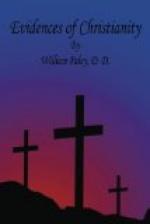This species of evidence comes later than the rest; as it was not natural that catalogues of any particular class of books should be put forth until Christian writings became numerous; or until some writings showed themselves, claiming titles which did not belong to them, and thereby rendering it necessary to separate books of authority from others. But, when it does appear, it is extremely satisfactory; the catalogues, though numerous, and made in countries at a wide distance from one another, differing very little, differing in nothing which is material, and all containing the four Gospels. To this last article there is no exception.
I. In the writings of Origen which remain, and in some extracts preserved by Eusebius, from works of his which are now lost, there are enumerations of the books of Scriptures, in which the Four Gospels and the Acts of the Apostles are distinctly and honourably specified, and in which no books appear beside what are now received. The reader, by this time, will easily recollect that the date of Origen’s works is A.D. 230. (Lardner, Cred. vol. iii. p. 234, et seq.; vol. viii. p. 196.)
II. Athanasias, about a century afterwards, delivered a catalogue of the books of the New Testament in form, containing our Scriptures and no others; of which he says, “In these alone the doctrine of Religion is taught; let no man add to them, or take anything from them.” (Lardner, Cred. vol. ii. p. 223.)
III. About twenty years after Athanasius, Cyril, bishop of Jerusalem, set forth a catalogue of the books of Scripture, publicly read at that time in the church of Jerusalem, exactly the same as ours, except that the “Revelation” is omitted. (Lardner, Cred. vol. ii. p. 270.)
IV. And fifteen years after Cyril, the council of Laodicea delivered an authoritative catalogue of canonical Scripture, like Cyril’s, the same as ours with the omission of the “Revelation.”
V. Catalogues now became frequent. Within thirty years after the last date, that is, from the year 363 to near the conclusion of the fourth century, we have catalogues by Epiphanius, (Lardner, Cred. vol. ii. p. 368.) by Gregory Nazianzen, by Philaster, bishop of Breseia in Italy, (Lardner, Cred. vol. ix. p. 132 & 373.) by Amphilochius, bishop of Iconium; all, as they are sometimes called, clean catalogues (that is, they admit no books into the number beside what we now receive); and all, for every purpose of historic evidence, the same as ours. (Epiphanius omits the Acts of the Apostles. This must have been an accidental mistake, either in him or in some copyist of his work; for he elsewhere expressly refers to this book, and ascribes it to Luke.)
VI. Within the same period Jerome, the most learned Christian writer of his age, delivered a catalogue of the hooks of the New Testament, recognising every book now received, with the intimation of a doubt concerning the Epistle to the Hebrews alone, and taking not the least notice of any book which is not now received. (Lardner, Cred. vol. x. p. 77.)




